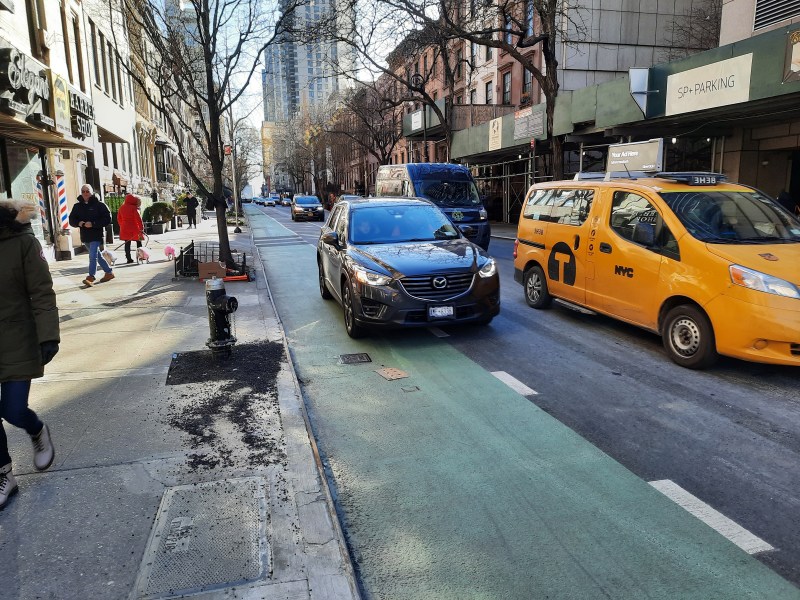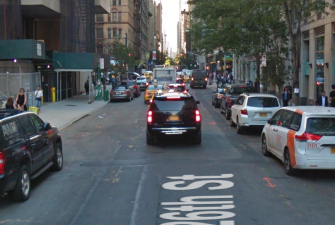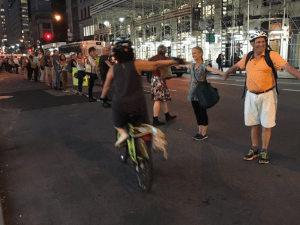EYES ON THE STREET: East Side Bike Lane Where Driver Killed Two Remains Unfixed
A month after a preventable tragedy, long-noted flaws persist.

Where’s Ydanis?
A month after our then-incoming transportation commissioner vowed to fix the flawed design of the unprotected bike lane where a truck driver mowed down a delivery cyclist and a pedestrian, the city has done nothing to stop motorists from mobbing the bike facility.

At the site of the Dec. 24 crash at 61st Street and Third Avenue, where the Baldor truck driver struck with enough force to dislodge a fire hydrant, conditions in the crosstown bike lane remain beyond an embarrassment. Drivers regularly use the unprotected lane either as an unofficial turn lane onto Third or as an extra lane of traffic, driving at speeds that put any cyclists in the lane in serious danger. The abuse is most noticeable between First and Third avenues, where westbound traffic from the 59th Street Bridge and FDR Drive combines, and impatient motorists often drive recklessly.
The DOT’s lack of action is dismaying. The double-fatality crash shocked and horrified a city where single traffic fatalities are so common that they barely raise an eyebrow, and provoked an immediate reaction from Rodriguez, who attended a vigil for the cyclist two days later. That happened as the DOT took angry questions about why the bike lane — which it had promised would be protected from Day One — was so visibly and easily permeable to vehicles, especially when the temporary lane that preceded it had flex posts visibly separating it from the car lanes.
Rodriguez also reiterated a promise that he had made only days earlier, that his agency would quickly reinforce half of the city’s plastic-protected bike lanes with tougher materials.
How has that been working?
The bike-lane conditions on these streets now are so unsafe that one wonders if the DOT even got the memo.
The horrendous crash was only the latest chapter in the drawn-out saga of the 61st and 62nd street crosstown bike lanes — one that is widely considered ugly even by normal “bikelash” standards. Hostility from bike-lane opponents (including one from California!) marred the community-board meetings on the lanes, delaying for months the implementation of the permanent lanes even though essential workers, such as hospital employees, had come to rely on the temporary lanes for commuting during the pandemic. The department began putting in the facilities at the end of last summer — and I and other users began noting the deficiencies.

Every problem that contributed to the Baldor crash was present in some form — and complained about by area residents and cyclists — before the crash threw them into sharp relief. The fact that not even a two-fatality crash has led to immediate safety changes for bike lanes that are visibly dangerous speaks to an institutional sluggishness that must change if Rodriguez’s (and Mayor Adams’s, for that matter) ambitious street-safety goals are to be met.

As I noted in Streetsblog last August, on both the 61st and 62nd street lanes, further west between Park and Madison avenues, obstructions, notably restaurants’ outdoor structures placed directly in the painted lane in several locations on 62nd Street, make the lanes unusable. On 61st Street between Park and Madison, the DOT has not painted or marked the lane at all, months after designating it as such.

The connection infrastructure is similarly dangerous. The two-way connection from the lanes to the path on the 59th Street Queensboro Bridge is both unprotected and directly in conflict with turning vehicles coming off the bridge onto 60th Street, creating conditions for drivers to hit cyclists who legally must go against car and bus traffic. On the two-way 60th Street lane between York and First Avenues, MTA bus parking makes the lane mostly unusable.

So, sickeningly, a month later, a repeat of something akin to the Baldor crash could still happen if the stars align. The question is whether the bike lanes will be made safe before a deadly crash occurs again.
Liam Jeffries (@liamjeffries3) is a safe-streets activist and freelance writer in Manhattan.

